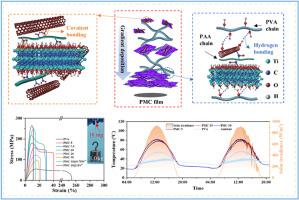通过共价交联的纳米模拟PVA/MXene/CNTs薄膜:协同力学、光热转换和可持续能源应用的辐射冷却
IF 4.5
2区 化学
Q2 POLYMER SCIENCE
引用次数: 0
摘要
有效利用清洁太阳能热仍然是应对全球能源挑战的重要途径。Ti3C2Tx MXene具有优异的导热性和机械强度,但其加入到聚合物复合材料中受到界面相互作用弱和分散性差的阻碍。本研究提出了一种共价工程策略,通过酯化交联构建MXene/碳纳米管(CNT)杂化填料,其中聚丙烯酸(PAA)桥接富含羟基的聚多巴胺包被的CNTs和MXene纳米片。通过溶液铸造制备的聚乙烯醇/MXene/碳纳米管(PMC)复合薄膜具有独特的梯度沉积结构。优化后的PMC-10薄膜具有优异的力学性能,拉伸强度为216 MPa,杨氏模量为3.07 GPa,分别是原PVA的2.8倍和5.1倍。同时,复合材料表现出双模热调节能力:白天光热加热增强45.43°C,夜间辐射冷却降低7.47°C。这种日热梯度使24小时连续热电发电成为可能。此外,PMC薄膜显示快速融冰能力,有效的散热和改进的阻燃性。这项工作为设计聚合物复合材料中的1D/2D共价杂化填料建立了一个范例,同时提高了机械性能和多功能性能,显着扩大了其可持续能源应用的潜力。本文章由计算机程序翻译,如有差异,请以英文原文为准。


Nacre-mimetic PVA/MXene/CNTs films via covalent crosslinking: Synergistic mechanics, photothermal conversion, and radiative cooling for sustainable energy applications
Efficient utilization of clean solar thermal energy remains for addressing the global energy challenges. Ti3C2Tx MXene exhibits exceptional thermal conductivity and mechanical strength, however, its incorporation into polymer composites is hindered by weak interfacial interactions and poor dispersion. This study presents a covalent engineering strategy to construct MXene/carbon nanotube (CNT) hybrid fillers through esterification crosslinking, where polyacrylic acid (PAA) bridges hydroxyl-rich polydopamine-coated CNTs and MXene nanosheets. The resulting polyvinyl alcohol/MXene/CNTs (PMC) composite films fabricated through solution casting exhibit a unique gradient deposition architecture. The optimized PMC-10 film has excellent mechanical properties with a tensile strength of 216 MPa and a Young's modulus of 3.07 GPa, which are 2.8 and 5.1 times higher than those of the original PVA, respectively. Meanwhile, the composite simultaneously exhibits dual-mode thermal regulation capabilities: daytime photothermal heating enhancement of 45.43 °C and nighttime radiative cooling reduction of 7.47 °C. This diurnal thermal gradient enables continuous 24-h thermoelectric generation. Furthermore, the PMC films display rapid ice-melting capabilities, efficient heat dissipation, and improved flame retardancy. This work establishes a paradigm for designing 1D/2D covalent hybrid fillers in polymer composites that simultaneously enhance mechanical properties and multifunctional performance, significantly expanding their potential for sustainable energy applications.
求助全文
通过发布文献求助,成功后即可免费获取论文全文。
去求助
来源期刊

Polymer
化学-高分子科学
CiteScore
7.90
自引率
8.70%
发文量
959
审稿时长
32 days
期刊介绍:
Polymer is an interdisciplinary journal dedicated to publishing innovative and significant advances in Polymer Physics, Chemistry and Technology. We welcome submissions on polymer hybrids, nanocomposites, characterisation and self-assembly. Polymer also publishes work on the technological application of polymers in energy and optoelectronics.
The main scope is covered but not limited to the following core areas:
Polymer Materials
Nanocomposites and hybrid nanomaterials
Polymer blends, films, fibres, networks and porous materials
Physical Characterization
Characterisation, modelling and simulation* of molecular and materials properties in bulk, solution, and thin films
Polymer Engineering
Advanced multiscale processing methods
Polymer Synthesis, Modification and Self-assembly
Including designer polymer architectures, mechanisms and kinetics, and supramolecular polymerization
Technological Applications
Polymers for energy generation and storage
Polymer membranes for separation technology
Polymers for opto- and microelectronics.
 求助内容:
求助内容: 应助结果提醒方式:
应助结果提醒方式:


